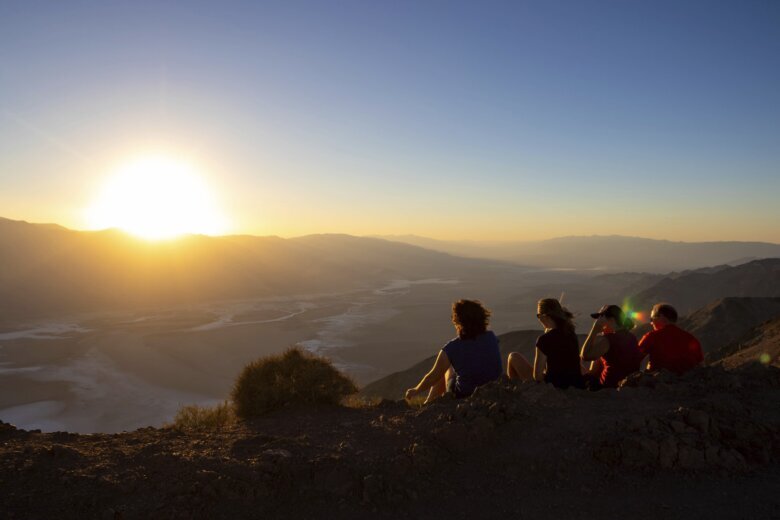
DEATH VALLEY, Calif. (AP) — Long the hottest place on Earth, Death Valley put a sizzling exclamation point Sunday on a record warm summer that is baking nearly the entire globe by flirting with some of the hottest temperatures ever recorded, meteorologists said.
Temperatures in Death Valley, which runs along part of central California’s border with Nevada, reached 128 degrees Fahrenheit (53.33 degrees Celsius) on Sunday at the aptly named Furnace Creek, the National Weather Service said.
The hottest temperature ever recorded on Earth was 134 F (56.67 C) in July 1913 at Furnace Creek, said Randy Ceverny of the World Meteorological Organization, the body recognized as keeper of world records. Temperatures at or above 130 F (54.44 C) have only been recorded on Earth a handful of times, mostly in Death Valley.
“With global warming, such temperatures are becoming more and more likely to occur,” Ceverny, the World Meteorological Organization’s records coordinator, said in an email. “Long-term: Global warming is causing higher and more frequent temperature extremes. Short-term: This particular weekend is being driven by a very very strong upper-level ridge of high pressure over the Western U.S.”
Furnace Creek is an unincorporated community within Death Valley National Park. It’s home to the park’s visitor center, which includes a digital thermometer popular with tourists. On Sunday afternoon, dozens of people gathered at the thermometer — some wearing fur coats as a joke — hoping to snap a picture with a temperature reading that would shock their friends and family.
That digital thermometer hit 130 degrees at one point on Sunday, but it’s not an official reading. The National Weather Service said the highest temperature recorded on Sunday was 128 F (53.3 C) — a high that was unlikely to be surpassed as the sun went down.
A few miles away at Badwater Basin — the lowest point in North America at 282 feet (85.95 meters) below sea level — tourists took selfies and briefly walked along the white salt flats ringed by sandy-colored mountains as wisps of clouds crawled overhead. Meteorologists say that thin cloud cover most likely kept temperatures from reaching potential record highs.
William Cadwallader lives in Las Vegas, where temperatures reached 116 F (46.67 C) on Sunday, nearing the all-time high of 117 degrees. But Cadwallader said he’s been visiting Death Valley during the summer for years just to say he’s been to the hottest place on Earth.
“I just want to go to a place, sort of like Mount Everest, to say, you know, you did it,” he said.
The heat wave is just one part of the extreme weather hitting the U.S. over the weekend. Five people died in Pennsylvania on Saturday when heavy rains caused a sudden flash flood that swept away multiple cars. A 9-month-old boy and a 2-year-old girl remained missing. In Vermont, authorities were concerned about landslides as rain continued after days of flooding.
Death Valley’s brutal temperatures come amid a blistering stretch of hot weather that has put roughly one-third of Americans under some type of heat advisory, watch or warning. Heat waves are not as visually dramatic as other natural disasters, but experts say they are more deadly. A heat wave in parts of the South and Midwest killed more than a dozen people last month.
Residents in the western U.S. have long been accustomed to extreme temperatures, and the heat appeared to prompt minimal disruptions in California over the weekend. Local governments opened cooling centers for people without access to air conditioning to stay cool. The heat forced officials to cancel horse racing at the opening weekend of the California State Fair as officials urged fair-goers to stay hydrated and seek refuge inside one of the seven air-conditioned buildings.
Temperatures in Phoenix hit 114 F (45.56 C) on Sunday, the 17th consecutive day of 110 degrees or higher. The record is 18 days, set in June 1974. Phoenix is on track to break that record on Tuesday, said Gabriel Lojero, a meteorologist with the National Weather Service.
Heat records are being shattered all over the U.S. South, from California to Florida. But it’s far more than that. It’s worldwide, with devastating heat hitting Europe along with dramatic floods in the U.S. Northeast, India, Japan and China.
For nearly all of July, the world has been in uncharted hot territory, according to the University of Maine’s Climate Reanalyzer.
June was also the hottest June on record, according to several weather agencies. Scientists say there is a decent chance that 2023 will go down as the hottest year on record, with measurements going back to the middle of the 19th century.
Death Valley dominates global heat records. In the valley, it’s not only hot, it stays brutally warm.
Some meteorologists have disputed how accurate Death Valley’s 110-year-old hot-temperature record is, with weather historian Christopher Burt disputing it for several reasons, which he laid out in a blog post a few years ago.
The two hottest temperatures on record are the 134 F in 1913 in Death Valley and 131 F (55 C) in Tunisia in July 1931. Burt, a weather historian for The Weather Company, finds fault with both of those measurements and lists 130 F (54.4 C) in July 2021 in Death Valley as his hottest recorded temperature on Earth.
“130 degrees is very rare if not unique,” Burt said.
In July 2021 and August 2020, Death Valley recorded a reading of 130 F (54.4 C), but both are still awaiting confirmation. Scientists have found no problems so far, but they haven’t finished the analysis, NOAA climate analysis chief Russ Vose said.
There are other places similar to Death Valley that may be as hot, such as Iran’s Lut Desert, but like Death Valley are uninhabited so no one measures there, Burt said. The difference was someone decided to put an official weather station in Death Valley in 1911, he said.
A combination of long-term human-caused climate change from the burning of coal, oil and natural gas is making the world hotter by the decade, with ups and downs year by year. Many of those ups and downs are caused by the natural El Nino and La Nina cycle. An El Nino cycle, the warming of part of the Pacific that changes the world’s weather, adds even more heat to the already rising temperatures.
Scientists such as Vose say that most of the record warming the Earth is now seeing is from human-caused climate change, partly because this El Nino only started a few months ago and is still weak to moderate. It isn’t expected to peak until winter, so scientists predict next year will be even hotter than this year.
___
Borenstein reported from Washington and Beam reported from Sacramento, California.
__
Follow AP’s climate and environment coverage at https://apnews.com/hub/climate-and-environment
__
Associated Press climate and environmental coverage receives support from several private foundations. See more about AP’s climate initiative here. The AP is solely responsible for all content.
Copyright © 2024 The Associated Press. All rights reserved. This material may not be published, broadcast, written or redistributed.







